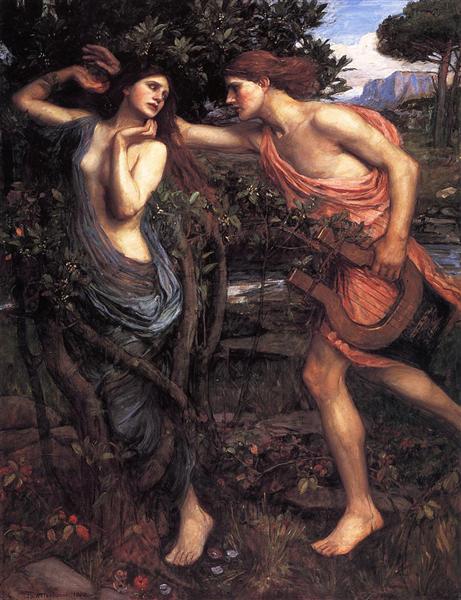תיאור
הציור "אפולו ודאפנה" משנת 1908, שנוצר על ידי ג'ון וויליאם ווטרהאוס, הוא יצירה שמכסה את מהות הסמליות ואת התנועה הקדם -רפליסטית, אותה אימץ האמן לאורך הקריירה שלו. קטע זה הוא תוצאה של חקר עמוק של המיתולוגיה הקלאסית, במיוחד ההיסטוריה הטרגית של אפולו, אל האור והמוזיקה היווני, ודאפנה, נימפה שהופכת לאישיות טיסה ושינוי.
הרכב היצירה מדהים לשימוש הדינאמי שלה במרחב והאינטראקציה בין הדמויות. ווטרוס מציגה את אפולו, בצד שמאל, כצעיר שרירי וקורן, שנמצא ביישום פעיל, כמעט רוקד לעבר דפנה. ביטויו חושף גם געגוע ונחישות, ומכסה את הלהט שהוא מרגיש עבור המוזה שלו. גופך מדגמן עם אור רך שמדגיש את מעמדו האלוהי, באמצעות גוונים מוזהבים וחמים המנוגדים לסביבה הטבעית.
דפנה, בינתיים, מתנגד באלכסון לאפולו, מראה ביטוי של ייסורים ותסכול. הדרמה של תנוחתו מציעה טרנספורמציה קרובה, בה עורו מתחיל לעטוף עם קליפת עץ. לוח הצבעים בדמותו קר יותר, עם גווני ירוק וחום המגיבים לקשר שלו עם הטבע ורצונו לברוח. ניגודיות זו בין שתי הדמויות לא רק מדגישה את מתח הקריינות, אלא גם מחזקת את הדואליות של אהבה וחופש.
הבחירה של ווטרהאוס לייצג אותם ברגע מכריע של המיתולוגיה מוסיפה עומק פסיכולוגי לעבודה. זה לא סתם ייצוג של מפגש, אלא רגע קפוא שמוביל לייסורים של דפנה ולתשוקה המושלמת של אפולו. כאשר מבטו של הצופה עובר את הסצינה, השימוש העסקי באלמנטים הטבעיים המסגר את דפנה, כמו העלים והענפים המדכאים אותה בהדרגה, המסמלים את בלתי נמנעות של לכידתו ושינויו.
עבודתו של ווטרהאוס נאמנה לאסתטיקה טרום -רפאלסטית, המסומנת על ידי תשומת ליבו לפרטים הקטנים ולשימוש בצבעים. קפלי הבגדים, שנראים כמתוכננים את תנועת האוויר, והפרטים העדינים של הסביבה הטבעית מרמזים על אהבה ליופי ולשלמות חזותית. אסתטיקה זו מרגישה חיה במיוחד באופן בו מנוהלים יסודות הפרחים והעץ המופיעים לאורך כל הקומפוזיציה, תוך שילוב סימבולוגיה עשירה שמהדהדת את סמליות ווטרהאוס המתוחכמת.
בנוסף, ההקשר ההיסטורי של יצירת יצירה זו הוא בתקופה בה ההתעניינות באמנות קלאסית ומיתולוגית צצה מחדש במאה התשע עשרה ותחילת המאה העשרים. ווטרהאוס, שהושפע מבני דורו, מצליח להעניק ל"אפולו ודאפנה "פרשנות המשקפת הן את המורכבות הרגשית של דמויותיו ואת הסגנון העלילתי האופייני של יצירתו, שלעתים קרובות מבקשת לחקור את הקסים והחרדות האנושיות דרך פריזמת המיתולוגיה
לסיכום, "אפולו ודאפנה" היא יצירה עשירה שלא רק מדגישה את הכישורים הטכניים של ווטרהאוס, אלא גם מזמינה את ההתבוננות בנושאים אוניברסליים של תשוקה, טרנספורמציה והמאבק בין אהבה לחופש. המיזוג של הנרטיב המיתולוגי עם הביטוי האמנותי של ווטרהאוס הופך אותו לעדות מתמשכת של הקסם מהאמנות הקלאסית בתקופת מעבר למודרניות.
KUADROS ©, צבע מפורסם על הקיר שלך.
ציורי שמן בעבודת יד, עם איכות אמנים מקצועיים וחותם ייחודי של KUADROS ©.
שירות רבייה בתמונות עם ערבות שביעות רצון. אם אינך מרוצה לחלוטין מהעתק הציור שלך, אנו מחזירים את הכסף שלך 100%.

